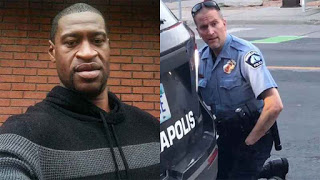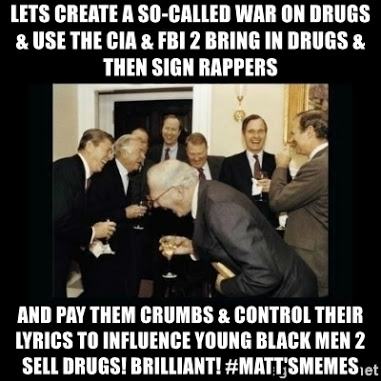
‘It is an outdated notion that people from El Salvador, Guatemala, and Honduras are primarily looking for economic opportunity in the United States and, therefore, should wait in line for a visa.
‘Citizens are murdered with impunity, kidnappings and extortion are daily occurrences.’

‘One new name has emerged as a possible victim of a wrongful arrest by police officer Gerald Goines – George Floyd.
‘Floyd, who died after a white officer held him under his knee in Minneapolis, grew up in Houston and was arrested by Goines in 2004 over a $10 (£8) drug transaction.
‘The 2004 arrest is now being re-examined by Kim Ogg, the district attorney in Houston’s Harris County, as part of the review of the former officer’s now-questionable cases.’
Probe into former police officer’s drug cases


‘For decades the US federal government has engaged in a shifting series of alliances of convenience with some of the world’s largest drug cartels…’
History Channel Tells the Secret History of the War On Drugs‘
‘Air America, a CIA front, flew supplies for the guerrillas into Laos and then flew drugs out, all with the knowledge and protection of U.S. operatives.
‘The same dynamic developed in the 1980s as the Reagan administration tried to overthrow the Sandinista government in Nicaragua. The planes that secretly brought arms to the contras turned around and brought cocaine back to America, again shielded from U.S. law enforcement by the CIA.
‘Most recently, there’s our 16-year-long war in Afghanistan… We installed Hamid Karzai as president while his brother apparently was on the CIA payroll and, simultaneously, one of the country’s biggest opium dealers. Afghanistan now supplies about 90 percent of the world’s heroin.’


Baby-faced dark web drug dealer Reece …
birminghammail.co.uk

378 Ottawa, Canada 26.20 7
379 Seoul, South Korea 26.15
380 Oakville, Canada 25.82
381 The Hague (Den Haag), Netherlands 25.67
382 Brasov, Romania 25.67
383 Graz, Austria 25.65
384 Gent, Belgium 25.64
385 Vienna, Austria 25.57
386 Aalborg, Denmark 25.55
387 Helsinki, Finland 25.52
388 Valencia, Spain 25.51
389 Mangalore, India 25.33
390 Eindhoven, Netherlands 24.54
391 Prague, Czech Republic 24.39
392 Timisoara, Romania 24.20
393 Tbilisi, Georgia 23.94
394 Coquitlam, Canada 23.75
395 Chiang Mai, Thailand 23.70
396 Rijeka, Croatia 23.47
397 Yerevan, Armenia 23.24
398 Stavanger, Norway 23.21
399 Amarillo, TX, United States 23.12
400 Tokyo, Japan 23.11
401 Markham, Canada 22.98
402 Tallinn, Estonia 22.69
403 Manama, Bahrain 22.42
404 Hong Kong, Hong Kong 22.26
The CIA, Contras, Gangs, and Crack – Institute for Policy Studies
‘In August 1996, the San Jose Mercury News initiated an extended series of articles linking the CIA’s “contra” army to the crack cocaine epidemic in Los Angeles. Based on a year-long investigation, reporter Gary Webb wrote that during the 1980s the CIA helped finance its covert war against Nicaragua’s leftist government through sales of cut-rate cocaine to South Central L.A. drug dealer, Ricky Ross. The series unleashed a storm of protest, spearheaded by black radio stations and the congressional Black Caucus, with demands for official inquiries. The Mercury News‘ Web page, with supporting documents and updates, received hundreds of thousands of “hits” a day.
The CIA, Contras, Gangs, and Crack – Institute for Policy Studies
‘While much of the CIA-contra-drug story had been revealed years ago in the press and in congressional hearings, the Mercury News series added a crucial missing link: It followed the cocaine trail to Ross and black L.A. gangs who became street-level distributors of crack, a cheap and powerful form of cocaine. The CIA’s drug network, wrote Webb, “opened the first pipeline between Colombia’s cocaine cartels and the black neighborhoods of Los Angeles, a city now known as the ‘crack’ capital of the world.” Black gangs used their profits to buy automatic weapons, sometimes from one of the CIA-linked drug dealers.
The Mercury News evidence of CIA complicity.
‘“In my 30year history in the Drug Enforcement Administration and related agencies, the major targets of my investigations almost invariably turned out to be working for the CIA.” — Dennis Dayle, former chief of an elite DEA enforcement unit.
‘The foregoing discussion should not be regarded as any kind of historical aberration inasmuch as the CIA has had a long and virtually continuous involvement with drug trafficking since the end of World War II.
1947 to 1951, France
‘CIA arms, money, and disinformation enabled Corsican criminal syndicates in Marseille to wrest control of labor unions from the Communist Party. The Corsicans gained political influence and control over the docks–ideal conditions for cementing a long-term partnership with mafia drug distributors, which turned Marseille into the postwar heroin capital of the Western world. Marseille’s first heroin laboratories were opened in 1951, only months after the Corsicans took over the waterfront.
Early 1950s, Southeast Asia
‘The Nationalist Chinese army, organized by the CIA to wage war against Communist China, became the opium baron of The Golden Triangle (parts of Burma, Thailand, and Laos), the world’s largest source of opium and heroin. Air America, the CIA’s principal proprietary airline, flew the drugs all over Southeast Asia.
1950s to early 1970s, Indochina
‘During U.S. military involvement in Laos and other parts of Indochina, Air America flew opium and heroin throughout the area. Many GI’s in Vietnam became addicts. A laboratory built at CIA headquarters in northern Laos was used to refine heroin. After a decade of American military intervention, Southeast Asia had become the source of 70 percent of the world’s illicit opium and the major supplier of raw materials for America’s booming heroin market.
1973 to 1980, Australia
‘The Nugan Hand Bank of Sydney was a CIA bank in all but name. Among its officers were a network of U.S. generals, admirals, and CIA men–including former CIA Director William Colby, who was also one of its lawyers. With branches in Saudi Arabia, Europe, Southeast Asia, South America, and the U.S., Nugan Hand Bank financed drug trafficking, money laundering, and international arms dealing. In 1980, amidst several mysterious deaths, the bank collapsed, $50 million in debt.
1970s and 1980s, Panama
‘For more than a decade, Panamanian strongman Manuel Noriega was a highly paid CIA asset and collaborator, despite knowledge by U.S. drug authorities as early as 1971 that the general was heavily involved in drug trafficking and money laundering. Noriega facilitated “guns-for-drugs” flights for the contras, providing protection and pilots, safe havens for drug cartel officials, and discreet banking facilities. U.S. officials, including then-CIA Director William Webster and several DEA officers, sent Noriega letters of praise for efforts to thwart drug trafficking (albeit only against competitors of his Medellín cartel patrons). The U.S. government only turned against Noriega, invading Panama in December 1989 and kidnapping the general, once they discovered he was providing intelligence and services to the Cubans and Sandinistas. Ironically, drug trafficking through Panama increased after the U.S. invasion.
1980s, Central America
‘The San Jose Mercury News series documents just one thread of the interwoven operations linking the CIA, the contras, and the cocaine cartels. Obsessed with overthrowing the leftist Sandinista government in Nicaragua, Reagan administration officials tolerated drug trafficking as long as the traffickers gave support to the contras. In 1989, the Senate Subcommittee on Terrorism, Narcotics, and International Operations (the Kerry committee) concluded a three-year investigation by stating: “There was substantial evidence of drug smuggling through the war zones on the part of individual contras, contra suppliers, contra pilots, mercenaries who worked with the contras, and contra supporters throughout the region. . . . U.S. officials involved in Central America failed to address the drug issue for fear of jeopardizing the war efforts against Nicaragua. . . . In each case, one or another agency of the U.S. government had information regarding the involvement either while it was occurring, or immediately thereafter. . . . Senior U.S. policy makers were not immune to the idea that drug money was a perfect solution to the contras’ funding problems.”
‘In Costa Rica, which served as the “Southern Front” for the contras (Honduras being the Northern Front), there were several CIA-contra networks involved in drug trafficking. In addition to those servicing the Meneses-Blandon operation (detailed by the Mercury News) and Noriega’s operation, there was CIA operative John Hull, whose farms along Costa Rica’s border with Nicaragua were the main staging area for the contras. Hull and other CIA-connected contra supporters and pilots teamed up with George Morales, a major Miami-based Colombian drug trafficker who later admitted to giving $3 million in cash and several planes to contra leaders. In 1989, after the Costa Rica government indicted Hull for drug trafficking, a DEA-hired plane clandestinely and illegally flew the CIA operative to Miami, via Haiti. The U.S. repeatedly thwarted Costa Rican efforts to extradite Hull to Costa Rica to stand trial.
Another Costa Rican-based drug ring involved a group of Cuban Americans whom the CIA had hired as military trainers for the contras. Many had long been involved with the CIA and drug trafficking. They used contra planes and a Costa Rican-based shrimp company, which laundered money for the CIA, to channel cocaine to the U.S.
‘Costa Rica was not the only route. Guatemala, whose military intelligence service–closely associated with the CIA–harbored many drug traffickers, according to the DEA, was another way station along the cocaine highway. Additionally, the Medellín cartel’s Miami accountant, Ramon Milian Rodriguez, testified that he funneled nearly $10 million to Nicaraguan contras through long-time CIA operative Felix Rodriguez, who was based at Ilopango Air Force Base in El Salvador.>
‘The contras provided both protection and infrastructure (planes, pilots, airstrips, warehouses, front companies, and banks) to these CIA-linked drug networks. At least four transport companies under investigation for drug trafficking received U.S. government contracts to carry nonlethal supplies to the contras. Southern Air Transport, “formerly” CIA-owned and later under Pentagon contract, was involved in the drug running as well. Cocaine-laden planes flew to Florida, Texas, Louisiana, and other locations, including several military bases. Designated as “Contra Craft,” these shipments were not to be inspected. When some authority wasn’t apprised and made an arrest, powerful strings were pulled to result in dropping the case, acquittal, reduced sentence, or deportation.
Mid-1980s to early 1990s, Haiti
‘While working to keep key Haitian military and political leaders in power, the CIA turned a blind eye to their clients’ drug trafficking. In 1986, the Agency added some more names to its payroll by creating a new Haitian organization, the National Intelligence Service (SIN). SIN’s mandate included countering the cocaine trade, though SIN officers themselves engaged in trafficking, a trade aided and abetted by some Haitian military and political leaders.
1980s to early 1990s, Afghanistan
‘CIA-supported Moujahedeen rebels engaged heavily in drug trafficking while fighting the Soviet-supported government, which had plans to reform Afghan society. The Agency’s principal client was Gulbuddin Hekmatyar, one of the leading drug lords and the biggest heroin refiner, who was also the largest recipient of CIA military support. CIA-supplied trucks and mules that had carried arms into Afghanistan were used to transport opium to laboratories along the Afghan-Pakistan border. The output provided up to one-half of the heroin used annually in the United States and three-quarters of that used in Western Europe. U.S. officials admitted in 1990 that they had failed to investigate or take action against the drug operation because of a desire not to offend their Pakistani and Afghan allies. In 1993, an official of the DEA dubbed Afghanistan the new Colombia of the drug world.’
Related posts:
Views: 0
 RSS Feed
RSS Feed

















 April 21st, 2021
April 21st, 2021  Awake Goy
Awake Goy 
 Posted in
Posted in  Tags:
Tags: 
















